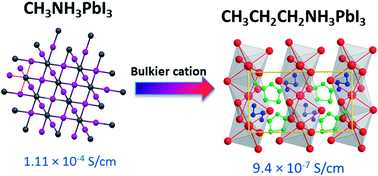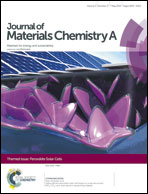Structure and function relationships in alkylammonium lead(ii) iodide solar cells†
Abstract
Alkylammonium lead(II) iodide materials (APbI3), based on the general formula of CH3–(CH2)n–NH3PbI3, may lead to a monumental leap in developing affordable photovoltaics. Herein, we correlate the structure and function relationships of alkylammonium lead(II) iodide in solar cells. We investigated changes in the structure of APbI3 materials by varying the alkylammonium cations in their structure. As the size of the alkylammonium cation increased, the crystallographic unit cell increased in size and yielded lower symmetry crystals. High symmetry materials, those with cubic symmetry, showed the highest conductivity, the smallest bandgap, and produced the best performing solar cells. Structural changes were investigated by X-ray crystallography, X-ray powder diffraction, and Raman scattering.

- This article is part of the themed collection: Perovskite Solar Cells

 Please wait while we load your content...
Please wait while we load your content...